Papers by Samuel Oppong Abebrese

Agricultural and Food Science Journal of Ghana, 2020
Rice (Oryza sativa L.) is the second most important cereal food crop in Ghana. Domestic productio... more Rice (Oryza sativa L.) is the second most important cereal food crop in Ghana. Domestic production of rice yields is low and Ghana produces only 30% of local demand. Rice blast has been the main constraint limiting local rice production in Ghana. The aim of this research was to isolate and morphologically characterize rice blast pathogen isolates obtained from Upper West, Upper East and Northern Regions of Ghana. In all, twenty-seven isolates were isolated and characterized morphologically on the basis of colony characters (colony color, surface texture, aerial mycelium, margin and size of the growing mycelium) and confirmed by microscopic examination of the conidia and conidiophores of the isolates. The colony color of the 27 isolates varied greatly from grey, light grey, black with thick cottony mass, grayish with white cottony mass, greenish, white, black and to creamy. The conidia of the isolates under 40x of the light microscope showed an oval shape, narrowed apex with 2 – 3 septate with long slender branched and unbranched conidiophore. Keywords: Rice Blast, Rice, Potato Dextrose Agar, Rice Blast Isolate
Agricultural Water Management
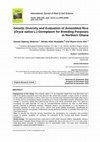
International Journal of Plant & Soil Science
Background of the Study: Rice (Oryza sativa L) is an important staple food crop that feed over ha... more Background of the Study: Rice (Oryza sativa L) is an important staple food crop that feed over half of the global population and it has become the cereal that provides a major source of calories for the urban and rural poor in Africa. Rice has is the second most important food staple after maize in Ghana and its consumption keeps increasing as a result of population growth, urbanization and change in consumer habits. Rice yield across Ghana is far below achievable yield. The need for increasing rice yield depends not only on cultural/traditional practices but also on their inbuilt genetic potential to withstand stresses. Adequate diverse rice germplasm is a pre-requisite for breeding varieties to meet local biotic, abiotic and grain quality challenges. Knowledge of germplasm diversity and genetic relationships among breeding materials is valuable information for crop improvement. Aim: To identify the diversity among assembled rice germplasms for evaluation and possibly exploit its g...

Hybrid rice varieties exploit the phenomenon of heterosis to out-yield their inbred counterpart t... more Hybrid rice varieties exploit the phenomenon of heterosis to out-yield their inbred counterpart to increase productivity per unit area. Unlike inbred rice varieties whose seeds could be used for replanting season after season, farmers will have to purchase seeds of hybrids every season to obtain the expected yield and other quality attributes. While the hybrid system is a disadvantage to farmers in terms of mandatory seed purchase, it serves as a motivation and opportunity for private seed companies to recoup their investment and therefore encourages their involvement in seed production research and development. Hybrid rice technology originated from China and is well commercialized in Asia and the Americas. Africa is among the few places where hybrid rice is still not fully commercialized. Besides Egypt, many African countries have just begun to exploit the benefits of hybrid rice technology. A number of introduced hybrids have exhibited a 15–20% yield advantage over the available ...
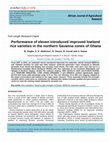
African Journal of Agricultural Research, 2016
From 2007 to 2010, we evaluated eleven introduced improved rice materials, mainly lowland NERICAs... more From 2007 to 2010, we evaluated eleven introduced improved rice materials, mainly lowland NERICAs and Thailand varieties for yield and other farmers’ preferred agronomic traits compared to Gbewaa (aromatic local check) and Digang (non aromatic local check). The trials, each year, were laid out in a Randomized Complete Block Designed (RCBD) with four replicates at two locations (Nyankpala and Salaga) in Northern Region, Ghana. Six cultivars namely, WAS 163-B-5-3, WAS 122-13-WAS-10-WAR, L2-4, PERFUME IRRIGATED, LONG GRAIN ORDINARY 2 and EXBAICA yielded significantly higher (p<0.5) with mean yield advantage range of 21 to 73% over Gbewaa, 16 to 66% over Digang, adapted to the target environment and tolerant to the major biotic stresses. These materials include two aromatic varieties which could serve as substitutes for Gbewaa (the market aromatic quality) and give farmers a choice to meet the existing market demand for aromatic rice. Key words: Rice evaluation, Savanna agro ecolog...

African Journal of Agricultural Research, 2011
Some selected first and second generation upland NERICAs (New Rice for Africa, genetic interspeci... more Some selected first and second generation upland NERICAs (New Rice for Africa, genetic interspecific materials derived from successful crossing of the two cultivated rice species Oryza sativa and Oryza glaberrima) were intercrossed to find out their level of cross-compatibility and the extent of sterility in the NERICAs. All hybrids were partially sterile and showed significant differences in their seed set (0.6 to 33.09%). The direction of crossing partly affected crossability in the NERICAs. Hybrids from crosses that maintained O. glaberrima cytoplasm, showed significantly higher (p ≤ 0.05) seed fertility than those that maintained O. sativa cytoplasm. Pollen fertility tests indicated reduced pollen viability in the hybrids. Seed set was improved (up to 65%) when hybrids were backcrossed to either parent. Cytoplasmic factors probably affected the degree of sterility in the NERICAs. Within the selected NERICAs improvement could therefore be possible through conventional crosses and...
Cover Crops and Sustainable Agriculture, 2021
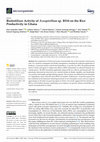
Microorganisms, 2021
Rice production in Ghana has become unsustainable due to the extremely nutrient-poor soils. It is... more Rice production in Ghana has become unsustainable due to the extremely nutrient-poor soils. It is caused by inadequate soil fertility management, including the inefficient application of fertilizers. A practical solution could be the biofertilizers, Azospirillum sp. B510. We performed field trials in Ghana and Japan to compare the effects of B510 colonization on selected Ghanaian rice varieties grown. The B510 inoculation significantly enhanced the rice cultivars’ growth and yield. The phenotypic characteristics observed in rice varieties Exbaika, Ex-Boako, AgraRice, and Amankwatia were mainly short length and high tillering capacity. These features are attributed to the host plant (cv. Nipponbare), from which the strain B510 was isolated. Furthermore, Azospirillum species has been identified as the dominant colonizing bacterium of rice rhizosphere across a diverse range of agroecologies in all major rice-growing regions in Ghana. Our results suggest that the utilization of B510 as ...
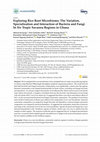
Sustainability, 2020
We investigated the root microbiomes of rice sampled from six major rice-producing regions in Gha... more We investigated the root microbiomes of rice sampled from six major rice-producing regions in Ghana using Illumina MiSeq high-throughput amplicon sequencing analysis. The result showed that both bacterial and fungal community compositions were significantly varied across the regions. Bacterial communities were shaped predominantly by biotic factors, including root fungal diversity and abundance. In contrast, fungal communities were influenced by abiotic factors such as soil nitrate, total carbon and soil pH. A negative correlation between the diversity and abundance of root fungi with soil nitrate (NO3-) level was observed. It suggested that there were direct and indirect effects of NO3- on the root-associated bacterial and fungal community composition. The gradient of soil nitrate from North to South parts of Ghana may influence the composition of rice root microbiome. Bacterial community composition was shaped by fungal diversity and abundance; whereas fungal community composition...
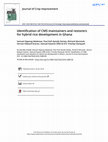
Journal of Crop Improvement, 2018
The cytoplasmic-genetic male sterility is the most widely used system for hybrid rice (Oryza sati... more The cytoplasmic-genetic male sterility is the most widely used system for hybrid rice (Oryza sativa) seed production. It requires three lines: the two hybrid parents (A and R lines) and a third line (maintainer (B line)), which maintains the sterility of the female parent during seed increase. Studies were undertaken to identify maintainers and restorers for introduced cytoplasmic male sterile (CMS) lines using simple sequence repeat (SSR) markers and testcrosses. Molecular screening with SSR marker RM6100 grouped the assembled inbred lines into 30 potential restorers and 55 potential maintainers. One maintainer (WAS 127-12-1-6-3-1) and 16 restorers were confirmed by testcrosses. WAS 127-12-1-2-3 had higher grain yield per plant in crosses with CMS1 (IR69625A) than the local checks (AgraRice and Jasmine 85) and could be used as a restorer to develop a locally adapted, high-yielding hybrid. Conversion of WAS 127-12-1-6-3-1 into a local CMS line was stopped because of sterility instability in the BC 1 F 1 generation. Continued testcrosses to the set of identified potential maintainers could help identify a stable one that can successfully be converted into a locally adapted CMS line.
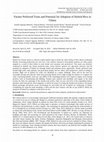
Sustainable Agriculture Research, 2019
Hybrid rice (Oryza sativa L) cultivars exploit hybrid vigor to break the yield ceiling of their i... more Hybrid rice (Oryza sativa L) cultivars exploit hybrid vigor to break the yield ceiling of their inbred counterpart thereby increasing productivity per unit area. Crop varieties released in developing countries are often poorly adopted as a result of their failure to meet farmer and consumer trait preferences. This study was therefore conducted to identify key farmer preferred traits, assess farmers' general rice agronomic practices and the potential for adoption of hybrid rice through formal and informal survey approaches. Farmer preferred traits include high yield, early maturity, and good grain quality, but few others, their preferences varied according to location. High cost of hybrid rice seeds was identified as a major challenge. There will be the need for reasonable pricing such that the return from growing hybrid seed is high enough for farmers to recognize the value of growing hybrids. Forty per cent (40%) of the responding farmers were found to employ seed wasting pract...
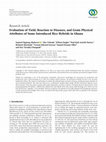
International Journal of Agronomy, 2019
Hybrid rice technology is one of the promising, sustainable, and proven technologies for increasi... more Hybrid rice technology is one of the promising, sustainable, and proven technologies for increasing rice production and productivity with a yield advantage of 15–30% over modern inbred varieties. The potential of hybrid rice has so far not been exploited in Ghana. This study was undertaken to evaluate the yield potential, reaction to diseases, and physical grain attributes of some introduced hybrids. The trials were laid out in a randomized complete block design (RCBD) with three replicates across three locations. Data were taken on grain yield, yield components, reaction to diseases, and grain physical characteristics. Four promising hybrids (SWARNA 2, ARGH 1501, ARGH 1502, and ARGH 1503) with a mean yield advantage of 15–20.8% over the best inbred check “AgraRice” were identified. With few exceptions, the hybrids were broadly adapted and had adequate resistance to blast and bacterial leaf blight. Most of the test hybrids had long slender grains which make them acceptable to the Gh...
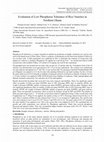
Sustainable Agriculture Research, 2015
Phosphorus (P) deficiency is a major constraint to upland rice production on highly weathered, lo... more Phosphorus (P) deficiency is a major constraint to upland rice production on highly weathered, low activity clay soils in the humid zones of West Africa. There is a paucity of information on the short-term fertilizer P effects on rice on these soils. A field experiment was conducted in 2011 to determine the response of twenty-four (24) upland rice cultivars to fertilizer Phosphorus (P) applied at 0 and 60 kg P ha−1. An uncultivated field at SARI research area with available P (Bray 1) P content of 3.0 mg/kg was used for the experiment. The ploughed area was divided into two plots with one plot for +P and the other for -P treatment. Each of the 24 varieties was allocated three rows and spaced at 20 x 10 cm in four replications. The varieties were randomized for each replicate and planted on 2nd July 2011 at one seed per hill. Pre-emergence herbicide Pendimethaline 400 g/l (Alligator) was applied at 3.2 L/ha two days after planting followed by one hand weeding. For the (-) P plot, the...

Annals of the New York Academy of Sciences, 2006
Spirochetes were first detected in mosquitoes, in 1907, by Jaffé. 1 The most studied spirochete d... more Spirochetes were first detected in mosquitoes, in 1907, by Jaffé. 1 The most studied spirochete during the past decades is perhaps Borrelia burgdorferi sensu lato, the etiologic agent of Lyme disease. 2 Lyme disease is widespread in North America and Eurasia, and has also been reported in North Africa. 3 To date, ixodid ticks are the only proven biological vectors of Lyme disease spirochetes. In the study we report here, the morphological characteristics of 10 strains, isolated from culicine mosquitoes in Southern Moravia (Czech Republic) is described. The following mosquitoes were collected and examined for the presence of spirochetes by darkfield microscopy: during the Summer season, Aedes vexans, Meigen 1830 (3/157) (number positive/number examined), Ae. sticticus (Meigen 1838) (5/204), Ae. cantans (Meigen 1818) (0/63), and Culex pipiens Linnaeus, 1758 biotype pipiens Forskal, 1775 (4/147); and during the Winter period the overwintering Culex pipiens Linnaeus, 1758 biotype molestus Forskal, 1775 (103/2012). The isolation attempts resulted in the recovery of 13 spirochetal strains that were successfully cultivated in BSK-H medium (Sigma). The morphological characteristics of 10 of these strains are presented in T ABLE 1. Using electron microscopy, the flagella inserted at both ends of the cells, were shown to be located in the periplasmic space. The cytoplasm was densely packed with ribosomes (see F IGURE 1). The phenomenon of “blebbing” and the formation of gemmae-like structures was also observed. Cell division by binary fission with the formation of septa was documented (see F IGURE 2). This feature discriminates Borrelia from Treponema, the latter dividing by constriction. We have detected spirochetes during the Summer season as well as throughout the Winter period (at least four months). The spirochetes isolated from the mosquitoes were found to be phenotypically heterogeneous (see T ABLE 1). Although Borrelia afzelii has recently been isolated from Aedes vexans in South Moravia, 5 most of the isolated spirochetes are likely to be commensals of the mosquito
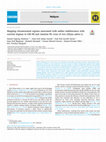
Heliyon, 2021
Anther indehiscence in certain wide crosses combines male sterility with stigma exertion, a pheno... more Anther indehiscence in certain wide crosses combines male sterility with stigma exertion, a phenomenon that is desirable for hybrid rice seed production. This study sought to identify chromosomal region(s) that combine anther indehiscence with exerted stigmas. A mapping population consisting of 189 BC 1 F 1 plants was derived from a cross between CRI-48 and Jasmine 85 and backcrossing the resulting F 1 to Jasmine 85. Contrary to the three complementary genes mode of inheritance reported earlier, a single locus (AI6-1) was mapped on chromosome 6 at 27.4 cM for anther indehiscence with exerted stigmas through a mixed model-based composite interval mapping (MCIM). This locus was flanked by two single nucleotide polymorphism (SNP) markers, K_ID6002884 and K_ID6003341 within a range of 23.1-28.9 cM. The allele at the locus was contributed by the CRI-48 parent which has Oryza glaberrima ancestry. This locus is suggested to control anther indehiscence and stigma exertion through pleiotropic gene action or cluster of genes.
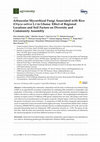
Understanding the community composition and diversity of arbuscular mycorrhizal fungi (AMF) in an... more Understanding the community composition and diversity of arbuscular mycorrhizal fungi (AMF) in an agricultural ecosystem is important for exploiting their potential in sustainable crop production. In this study, we described the genetic diversity and community structure of indigenous AMF in rain-fed rice cultivars across six different regions in Ghana. The morphological and molecular analyses revealed a total of 15 different AMF genera isolated from rice roots. Rhizophagus and Glomus were observed to be predominant in all regions except the Ashanti region, which was dominated by the genera Scutellospora and Acaulospora. A comparison of AMF diversity among the agroecological zones revealed that Guinea Savannah had the highest diversity. Permutational Multivariate Analysis of Variance (PERMANOVA) analysis indicated that the available phosphorus (AP) in the soil was the principal determining factor for shaping the AMF community structure (p < 0.05). We report, for the first time, AM...
Uploads
Papers by Samuel Oppong Abebrese